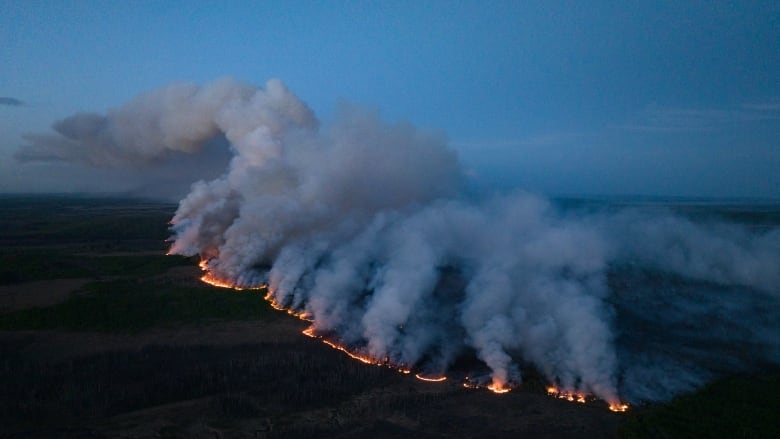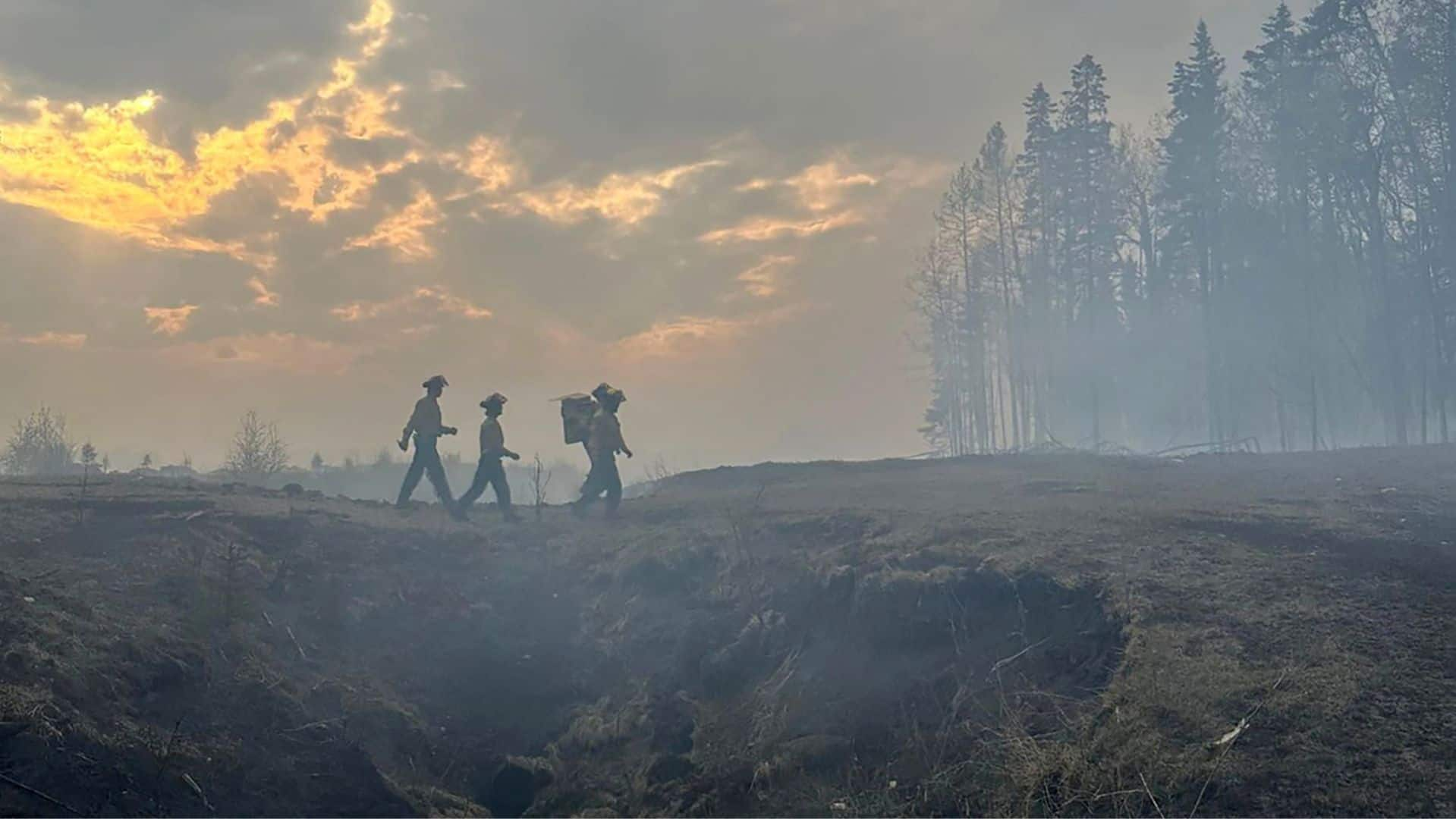ANALYSIS | No accounting for the cost of climate disasters like forest fires | CBC News
You don’t have to tell the people of Calgary and other Canadian communities breathing orange air that forest fires have a cost.
And while repeated studies draw a direct line between an increase in costly forest fires and climate change, economists and accountants right up to Canada’s Parliamentary Budget Officer say the benefits of stopping climate change and thus reducing the many harms it creates are simply impossible to measure for public accounting purposes.
It is an interesting conundrum and the thousands of people displaced from their homes or breathing smoke from the current spate of forest fires are caught in the middle.
While federal budgets include all the costs of fighting climate change, the other side of the ledger, the notional income from the benefits of you not breathing smoke, or at least breathing less, remain blank. Since there is no benefit, it is harder to justify spending the money.
Hard to ignore
While some of the effects of a warming planet seem distant from our daily lives, including the slow-moving impacts of rising sea levels or disasters affecting other people someplace far away, the smoke from forest fires has an in-your-face impact affecting millions of Canadians that makes it harder to ignore.
People in smoky areas are being advised to stay indoors, and repeated studies show high pollution days lead to increased deaths. Of course there are many costs from forest fires short of death. Some are relatively easy to calculate — like increased dollars spent on firefighting itself.
“The annual national cost of wildland fire protection exceeded $1 billion for six of the last 10 years,” says a data analysis from Natural Resources Canada. “On average, costs have risen about $150 million per decade since data collection started in 1970.”
Hundreds of firefighters from across Canada are helping to combat Alberta’s raging wildfires, just as B.C.’s worsening wildfire situation starts siphoning resources.
It’s much harder to capture the damage to the quality of your life from sheltering indoors, or facing a summer without blue skies or clean air.
Meanwhile nearly 20,000 have been forced from their homes. Properties have been lost. Hectares of burned forests in Alberta, nearly 700,000 ha this week — challenging the roughly 900,000 ha burned in all of 2019, the previous biggest fire year — represent trees that cannot be harvested, and are no longer absorbing carbon.
Oil and gas companies have been forced to shut down production again this week. In the past rail traffic has been interrupted by fires. A report from DBRS Canada out Wednesday said that while there have been rail service interruptions, grain shipments overall have not yet been seriously affected, although “the situation remains volatile and unpredictable.“
Spike in deaths
For Dave Sawyer, principal economist with the Canadian Climate Institute, the costs of climate change in our daily lives are obvious, including from the current forest fires.
“The particulate matter exposure and the air quality is serious,” said Sawyer on Wednesday. “There’s going to be a spike in deaths. There’s going to be a spike in morbidity outcomes, hospital visits, respiratory illness.”
“Really, there’s no minimum exposure.”
He is afraid that some people will refuse to accept the link between climate change and the increasingly costly disasters, including fires.
“Most, I think, will believe it,” he said.
Research from places like Europe and Australia have demonstrated a link between the hotter, drier, more volatile weather patterns caused by climate change and an increase in fire intensity. In Canada, Sawyer’s institute released a series of reports under the title The Cost of Climate Change that found similar effects using insurance data from across the country.
The federal disaster database goes back to 1971, while the Insurance Bureau of Canada publishes insured losses from 1983 onward.
“What we see is a spike,” said Sawyer, who adjusted the damages for the growing value of Canadian assets over that time. “So the frequencies have gone up and the damages have gone through the roof.”
Front Burner28:39Hotter, faster, more destructive: wildfire’s new reality
Albertans are suffering an unprecedented wildfire season. Tens of thousands have been evacuated out of the path of massive blazes. Across the province, skies are smoky and air quality is poor. Author John Vaillant is watching it unfold with a terrifying comprehension of the science of these super fires and just how dangerous they can be. He has spent years investigating what happened in 2016 when parts of Fort McMurray burned to the ground. His new book, ‘Fire Weather: The Making of a Beast,’ explains why the fires we battle today are hotter, faster and more destructive than the fires of before. He joins Alex Panetta for a conversation about the future of fire in our changing climate. For transcripts of this series, please visit: https://www.cbc.ca/radio/frontburner/transcripts
Counting the cost
Canada and the United States have recently put their heads together to update what they call “the social cost of carbon,” an attempt to quantify the losses from things like forest fires. The idea is that if fires and storms and floods are a cost to the Canadian economy, there is a value to spending to reduce that damage.
The effect is expected to rise with global average temperatures. This week the World Meteorological Association said we are heading for the feared 1.5 C of warming on average globally within five years — a threshold international climate agreements have pledged to stay below to avoid the worst consequences of climate change.
But turning those economic costs and benefits into hard numbers in the public accounts remains a nightmare, as the Parliamentary Budget Officer Yves Giroux explained to a parliamentary committee last month.
The budgetary figures do not count the “benefits of carbon emissions reduction because these are very difficult, it is very difficult to quantify in dollar terms the benefit of a reduction in greenhouse gas emissions,” said Giroux in response to a committee member’s question.

“If there was a way to quantify these benefits between now and 2030 of reducing carbon emissions, we’d be happy to consider and include them,” said the PBO, who reports to parliament, not to the government. “But the dollar benefits of transitioning to a greener economy between now and 2030 are very very difficult to assess.”
According to Sawyer there are a number of complicated reasons why.
One is the “broken window fallacy,” a well known phenomenon in economics where breaking all the windows in your house actually adds to economic growth as measured by GDP because the demand for new windows rises. In other words, the forest fires show up in GDP as an increase in economic activity as governments spend money on helicopters and water bombers and finding accommodation for displaced victims.
So, the high expense of dealing with climate catastrophe could, economically, look perversely good.
A wealth of clean air and forests
Another difficulty, said Sawyer, in calculating what is being lost — or what could be gained from action — is the issue of what economists call stock and flow.
The stock is the natural wealth which includes clean air and water, unburnt forests and houses and un-flooded land. While that bank account is being drawn down, we have no way to tally the balance falling.
“We don’t account for the depletion of that wealth,” he said. “We just look at the flow of income that comes off it.”
Sawyer said this is a fundamental problem of national accounting that we can see as we watch forests burn and choke on the resulting filthy air.
“The trouble is that we’re knocking the crap out of the stock — more damages, more forest fires,” said Sawyer. “And we’re not really understanding in the long term how our wealth is impacted.”
For all the latest business News Click Here

